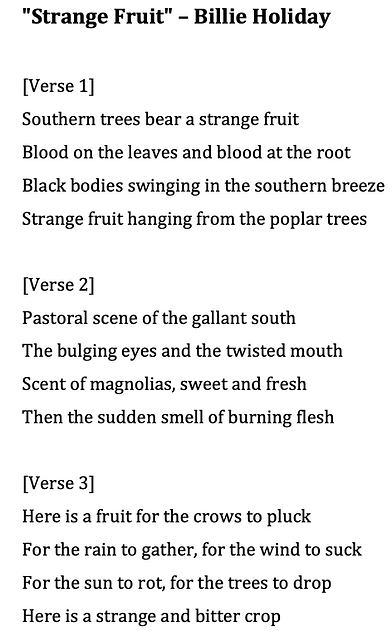voicing blackness
The Middle Passage
1500-1900
to next
Robert Hayden: "Middle Passage" (1962)
Sails flashing to the wind like weapons,
sharks following the moans the fever and the dying;
Revolt at Sea

Anti Epic
-
cinques as an anti-hero
-
real theme: heroic struggle for freedom by the Black victims
-
no direct statement of theme; instead, brief catalogue of the ships
-
epic premise of a quest-journey is established
Voice in the Middle Passage
-
multiple voices in the poem
-
voices of enslaved people are absent, while voices of the enslavers are present
-
shore is perceived as lucent and melting (highlights how mythical the notion of America as a melting pot is)
Irony in Slave Ship Names
Life Based on Death
names of slave ships that are linked with positive connotations and hope while they are actually a space of torture
The life of the enslaved people was based on death both during the Middle Passage and also on the shores of the New World.
ironic voice


After the Civil War: Segregation
1867-1964
to next
Billie Holiday: "Strange Fruit" (1939)
sampling

Kanye West: "Blood on the Leaves" (2013)
sampled "Strange Fruit"
re-voicing
re-using past voices to create a collective voice for contemporary voices of the Black Community
inverting
fruit doesn't signify death anymore, but pride
Harlem Renaissance
1918-mid 1930s
to next
The Project of the Harlem Renaissance was "to achieve through art the equality that [B]lack Americans had been denied in the social, political, and economic realms" (Wall 2016: 2).
"The Harlem Renaissance was the develop-ment of the Harlem neighborhood in New York City as a black cultural mecca in the early 20th Century and the subsequent social and artistic explosion that resulted. Lasting roughly from the 1910s through the mid-1930s, the period is considered a golden age in African American culture, manifesting in literature, music, stage performance and art."
Langston Hughes: "The Weary Blues" (1926)
blues as a
black voice
Blues
"Blues [is a form] of African-American folk music that trace[s] [its] roots to the system of slavery that dominated the American South prior to the Civil War. Blues songs developed from the sorrow-filled laments that were sung by slaves on plantations all across the South" (Hillstrom 57-58).
Kevin Hillstrom (2011):
Defining Moments. The Harlem Renaissance
Black Power Movement
1960-1970s
to next
Leroi Jones/Amiri Baraka: “Revolutionary Theatre” (1965)
"This should be a theatre of World Spirit. Where the spirit can be shown to be the most competent force in the world. Force. Spirit. Feeling. The language will be anybody's, but tightened by the poet's backbone. And even the language must show what the facts are in this consciousness epic, what's happening. We will talk about the world, and the preciseness with which we are able to summon the world, will be our art. Art is method. And art, "like any ashtray or senator" remains in the world."
'language' as a means to write back
King-Assassination Riots
1968
"A riot is the language of the unheard."
Martin Luther King, Jr.
Gwendolyn Brooks: "Riot" (1969)
epigraph
response to
sampled
Present & BLM
2013-
to end
-
9 African Americans killed by white supremacist at the Emanuel African Methodist Episcopal Church
-
one of the oldest Black churches in the US; center for organizing events related to civil rights
-
the first gunshot marks the transition from choral tones to trap sound: being Black as coming from (at least) two different sound worlds
-
the scenes of school children dancing while violence is behind them is a metaphor for Black art in Pop culture distracting from the real issues and violence against Black people: there is no escape from violence, not even in Pop culture


After Donald Glover shoots people in the video, the guns he used are treated with great care; they are wrapped in a red cloth. Victims, however, remain on the ground or are simply dragged away. Moreover, in both cases, the gun is given to school children indicating how easy it is - even for teenagers - to acquire a gun in the US.
A well regulated militia, being necessary to the security of a free state, the right of the people to keep and bear arms, shall not be infringed.
Shooting of Stephan Clark (2018)
"Before the video was released, this was the Sacramento police’s explanation of what transpired on March 18: 'Prior to the shooting, the involved officers saw the suspect facing them, advance forward with his arms extended, and holding an object in his hands. At the time of the shooting, the officers believed the suspect was pointing a firearm at them. After an exhaustive search, scene investigators did not locate any firearms. The only item found near the suspect was a cell phone.'"
linked to
First Horseman of the Apocaplypse
The Four Horsemen of the Apocalypse are figures in Christian faith, appearing in the New Testament's final book, Revelation, an apocalypse written by John of Patmos, as well as in the Old Testament's prophetic Book of Zechariah, and in the Book of Ezekiel, where they are named as punishments from God. (Wikipedia)


The material on this page was compiled, created, and arranged by Desiree Noser and Melisa Demir.



.png)
.png)







